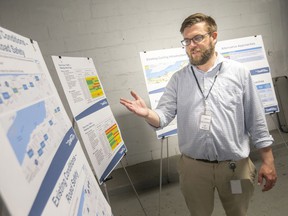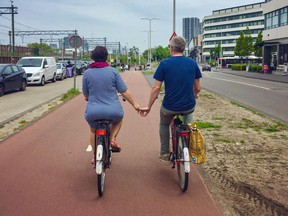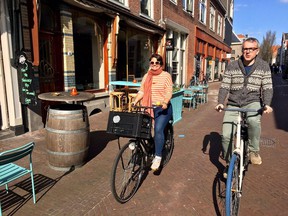
Article content
Painted bike lanes, raised sidewalks through intersections and flex posts popping up in the middle of streets are just some of the ideas that are new to Windsor and are being considered to make local streets safer and more comfortable for cyclists and pedestrians.
Advertisement 2
Article content
A virtual workshop Tuesday on how the Netherlands began sharing road space with non-motorized traffic, and the lessons learned, has given local planners, engineers and other municipal administrators inspiration to try out new ideas.
“It was good to hear fresh perspectives on things we can do in Windsor,” said Jeff Hagan, the city’s transportation planning senior engineer. “It gave us food for thought on new approaches we can take.”
The city is about to embark on its first pilot project with physically separated bike lanes, along a stretch of University Avenue connecting the downtown with the University of Windsor’s main campus. Separately, community consultations are underway on how to address traffic patterns on Wyandotte Street through east Windsor; and council has given the go-ahead for active transportation infrastructure and traffic calming measures along Kildare Road between Ottawa Street and Tecumseh Road West.
advertisement 3
Article content
“I think there’s certainly an appetite for more choice in transportation,” said Hagan, one of about 30 participants at the workshop led by four consultants from three countries connected to the Dutch Cycling Embassy. Hosted by the Windsor Law Center for Cities and the Windsor Essex County Environment Committeethe four-hour session was closed to the general public to help facilitate open discussion.

With speeding and aggressive driving through residential neighborhoods a big source of citizen complaints, city council recently amended Windsor’s traffic calming policy, and each ward can now invest up to $10,000 annually in temporary traffic calming measures.
Some of the suggested traffic calming tools discussed at this week’s workshop will be implemented locally, according to Hagan, including a proposed lower posted speed limit of 30 km/h along residential stretches of Kildare Road, separated bike lanes, and simple measures like painted pavement markings and centreline flex posts aimed at further calming traffic.
advertisement 4
Article content
Lower motor-vehicle speeds and physical traffic calming measures are essential when it comes to sharing roads with other users like cyclists, workshop participants heard. Hagan said something done differently in the Netherlands, where large numbers of commutes and short trips are taken by bicycle, is designing and building sidewalks at grade, with vehicles having to climb that level at intersections, which has a traffic-calming effect.
Sumaiya Habiba, Essex County’s environmental co-ordinator, said what she found most interesting and surprising was how successful other cities have been in garnering public support for this “multi-modal approach” to getting around, with cyclists, pedestrians and motorists sharing the road . Designing “colored paths” — green paint or red asphalt — for cyclists, for example, provides motorists with a “very clear visual” that other types of users are on the road, she said.
advertisement 5
Article content
Essex County’s growing County Wide Active Transportation System, encouraging people to use alternatives to motor vehicles to get around, has been a huge success, said Habiba. Ten years after its initiation, CWATS is currently being reviewed, with a goal of further extending the network’s reach to connect more communities.
Dave McLaughlin, a transportation planner with global planning and engineering consulting firm WSP Canada Inc.is helping with the update of CWATS, an Essex County plan he describes as “transformative — a very big success story,” and a model which other municipalities are seeking to emulate.

The pandemic, the climate crisis, and now record-high fuel costs, have opened the way for cities to try new things, said McLaughlin, like “road diets” (reduced lanes) to provide space for such alternatives as bike lanes and street boulevards for adjacent businesses.
advertisement 6
Article content
“Cities tried these as temporary measures, as pilot projects … and the doomsday predictions of some didn’t come to be,” said McLaughlin. In fact, he added, they proved so popular that cities from Toronto and Montreal to London and Kingston are turning what had been envisioned as short-term pilots into permanent changes.
Some business organizations, including neighborhood BIAs, are among those pushing for more “destination streets,” he said, with wider sidewalks, boulevards and bike lanes to increase traffic to commercial areas.
McLaughlin helped develop Windsor’s 2001 Bike Use Master Plan, which envisioned a citywide cycling network, one which was never fully implemented. He said he sees the same interest and excitement today as existed initially with BUMP 20 years ago.
Advertisement 7
Article content
“How we move is going to change,” he said.
-
Can Windsor evolve into a cycling city?
-
Lost parking under approved University Avenue revamp divides business owners
-
Friday’s Bike to Work Day ends with breakfast, survey
-
Windsor urged to follow Dutch cycling path to become healthier, wealthier city
Tuesday’s workshop, which followed an initial public seminar with authors and mobility experts Melissa and Chris Bruntlett, helps “contribute to a cultural shift and buy-in,” said Anneke Smit, director of the University of Windsor law school’s Center for Cities. The virtual session, which included representatives from Windsor Police Service and Transit Windsor, as well as city operations and engineering, planning, parks and environmental departments, was a gathering of the types of expertise needed to help make that happen, she said.
Hagan said something he’d like to see in the initial phase of the University Avenue West revamp is setting up different types of temporary or “pop-up” bike lane and other designs and then collecting feedback on what works best before final implementation.



